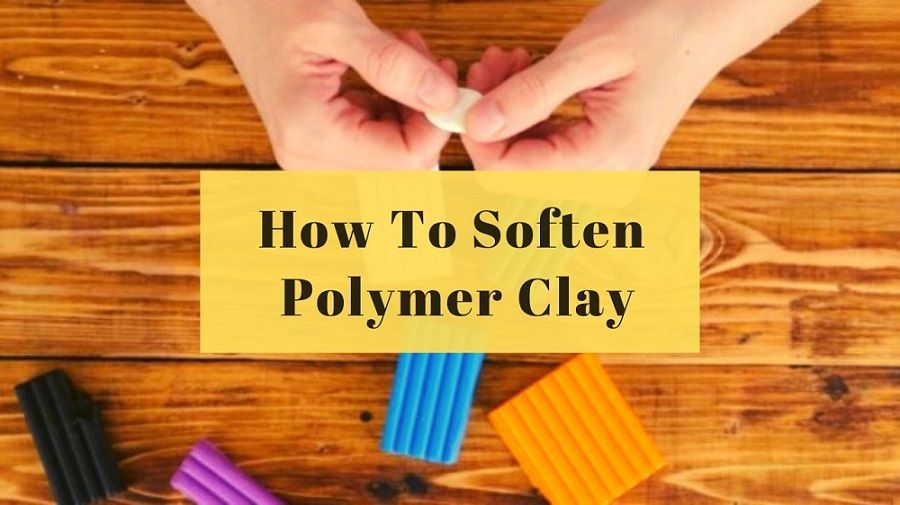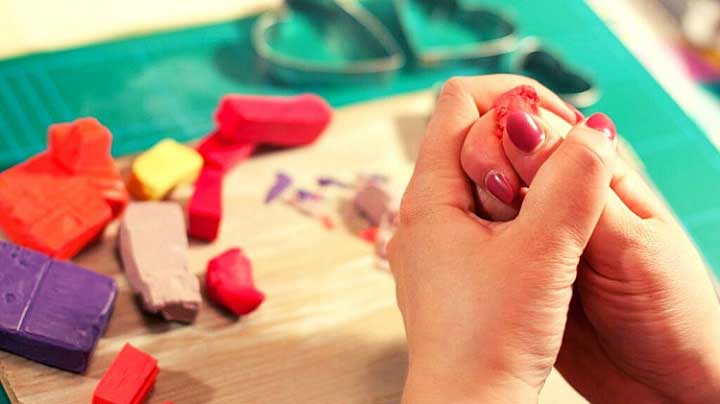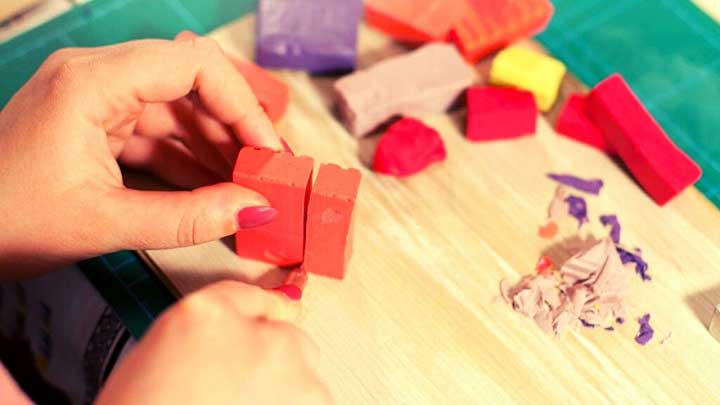
Working with hard polymer clay can be a real struggle for a craftsman.
After all, they do nothing but break and snap at you. You start to think that tossing them in the bin will be the best option.
Before doing so, have you ever thought of bringing the old slab of clay back to life? Did you know that you can restore the clay’s malleability?
You can do this by softening the clay using plasticizers. Dried blocks of clay have little to no plasticizers left in them. It is the key constituent that gives the clay its elastic properties.
In this article, we will learn how to soften polymer clay using three easy methods. With a bit of effort, you can restore an old brick of polymer clay to its prime state.
Let’s begin!
How To Soften Polymer Clay – 3 Easy ways

Polymer clays tend to get rock solid overtime if left uncovered. People may not realize the fact that polymer clay is salvageable no matter how hard they have become.
Let’s take a look at some of the ways you can use to revert your modeling clay to its soft state.
1. Using A Heat Source
You can soften the clay using your body heat. Alternatively, you can use a heating pad or even a hairdryer to soften them up. Applying a heat source allows you to revitalize and soften the clay. This method works best if your clay is partially hardened.
Here is how you can achieve a soft and workable clay:
Step 1:
Begin by warming the clay first. This can be done by kneading the clay over and over again until it gets a bit soft. It might be a slow process as the method requires a lot of elbow grease to soften the clay. You can also use a heat source like a hairdryer or a heating pad.
Step 2:
If you are using a heating pad, place it on top of the polymer clay. Keep it laid on for about 20 minutes. This will partially soften the clay.
Step 3:
The clay should now be kneadable. Roll the clay using your hand. The friction you generate helps soften the clay even further.
Step 4:
Place the clay on a counter and knead it. Use as much force as you can and keep reshaping and stretching the clay. This results in a soft, smooth, and workable clay.
You can also use a re-kneading machine if you prefer kneading the clay by hand.
2. Using Baby Oil
Softening clay using baby oil is an effective method. It is also easy and doesn’t require any tools or conditioners. Baby oils might not be meant to soften clay, but it considerably improves its texture. Here are the steps to achieve that:
Step 1:
The first step is to breakdown the clay into smaller pieces. If your clay is rock solid, use a mallet or hammer to crush them. This will increase the surface area of the clay and will make it easier to work with.
Step 2:
Put the pieces in a zip lock bag and add a few drops of baby oil in it. Gently work the clay with your hands until it starts to soften up.
You can also use a rolling pin to make the process a bit easier. If you don’t have a zip lock bag, a cling wrap will do just fine.
Step 3:
Take the clay out of the zip lock bag and start kneading it. The polymer clay will eventually become soft and pliable.
3. Using A Food Processor
Food processors can be effective at breaking down stiff clay. This negates the use of a hammer and a zip lock bag. If you have a large batch of hard clay, this method can be used to make them soft without putting in much effort.
Step 1:
Start by putting the clay in a food processor. If the pieces are too large they may not break apart easily. Chop them up into smaller pieces before grinding them.
Step 2:
After you have placed the pieces in a food processor, apply a few drops of diluent or liquid polymer clay. Put the lid on the food processor.
Step 3:
By using the highest setting, grind the clay in 10-second spurts. This will break down and mix the pieces with the diluent evenly. Keep grinding the polymer clay for up to 3 minutes, or until you think that the clay and the diluent are mixed.
Step 4:
Remove the clay from the food processor. You can use a plastic spoon to scrape the sides of the container to get most of the clay out. Once you have the clay out, press the pieces into a large clay ball.
Step 5:
The final step is to knead the clay ball. Keep kneading the clay to combine the pieces and work it even further. The polymer clay will eventually turn soft and ready for use.
Can All Hardened Polymer Clay Be Saved?
Hard polymer clay can be revitalized back into its softened form. The reason why polymer clays start to harden is because of heat. These modeling materials consist of plasticizers that give the clay their elastic properties.
If not used, the liquid medium leeches out of the polymer clay, making it dry and brittle.
Softening a clay is a long process. The aim is to rehydrate the clay which can be done using a few drops of plasticizers. Increasing the surface area of the clay will make the process much easier.
To do this, simply break it down into smaller pieces using a hammer. Insert the pieces in a small zip lock bag along with the plasticizer. Incorporate the two by squishing the plastic bag.
After that, take the clay out and lay it on a countertop. Then knead the clay thoroughly until it becomes soft and pliable.
If you follow the steps properly, there is a big chance that the old block of clay you stored in your shelf years ago can still be restored to its soft form.
Softening Polymer Clays – Tips And Cautions

1. Increase The Surface Area Of The Clay
If you want to soften a block of clay, it is better to cut or break it into smaller pieces first. This will increase the surface area of the clay and will have maximum contact with the plasticizers. It also makes working with the clay much easier.
2. Use Unscented Plasticizers
Conditioning hard polymer clay with scented mineral or baby oils may cause the clay to smell funny. Use an unscented plasticizer for a neutral smell.
3. Keep It Clean
Handling polymer clay can be messy. The color from the clay can shift to your hands or your workbench, staining them. Use a clear plastic bag to combine the clay and plasticizer. This way you can keep your hands from getting color stained.
4. Store Unused Clay Properly
An open block of polymer clay will get dry if not stored properly. You can store them away for years without it being dried and contaminated.
It is important to keep the clay away from excessive heat sources or direct sunlight. To do this, cover the clay using a plastic wrap. You can also put them on a lidded glass or metal container.
Clay kept on room temperature will stay malleable for years. The clay will last even longer if kept on cold storage such as a freezer.
5. Careful When Buying Polymer Clay From Online Retailers
When buying a clay online, look for a reputable distributor that has a high polymer clay turnover. Check for the reviews and see how many consumers are satisfied with the product. That will give you an idea about the quality of the clay.
Also, try to order the clay during the cooler months. While transporting the clay during the summers it can get cured in the back of a hot truck. Order during the spring and autumn months. They are the best times to buy polymer clays.
6. Leaching The Clay
So you are trying to soften some clay and you have added a bit too much plasticizer. What can you do to reverse it? Sure you can add more of the dry clay bits to balance the plasticizer to the clay ratio.
You can also remove the excess plasticizers by a process known as leaching. To do this, simply place the clay between sheets of plain paper and keep it aside.
The paper will start absorbing the excess liquid. You can also use this technique to alter the texture of the polymer clay.
Final Word
Polymer clay can be molded and deformed into various shapes, making it ideal arts and crafting work. If left isolated, the clay tends to lose its moisture over time. This makes it brittle and in most cases, unusable.
Restoring the malleability of polymer clays isn’t a difficult task at all. But you have to know how to soften polymer clay properly.
Although some polymer clays can be beyond restoring, you can still make use of most of the blocks in your shelf and revert it to its pliable state.
By applying the techniques mentioned in this article, you can successfully reach any level of softness you want. With a bit of effort, the once brittle, dry, and rigid clay can be good as new!
More articles about clay craft:
- Highest rated sculpting clay as of right now!
- The ultimate guide to sculpt with clay: Check here!